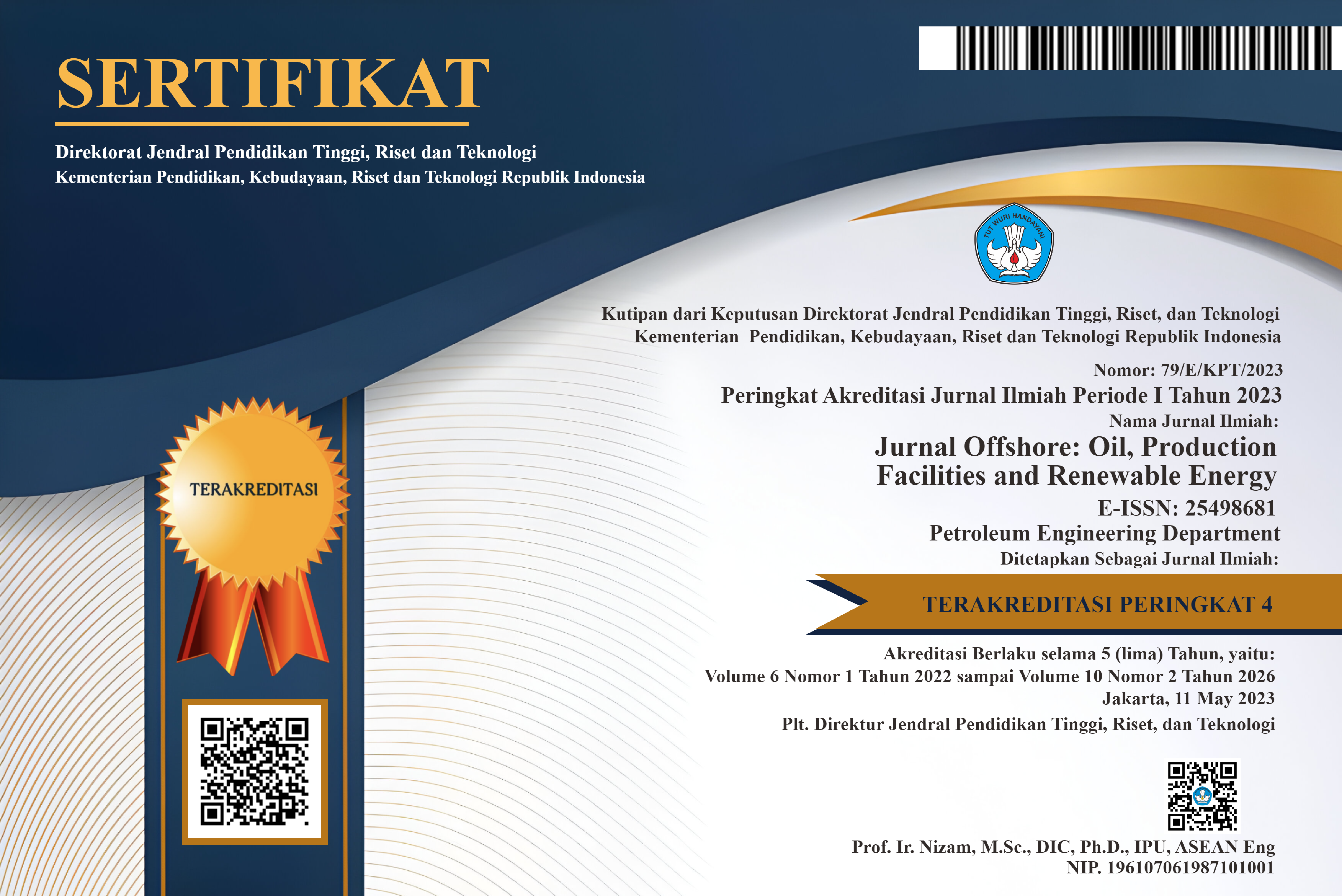Penentuan Sumur Pengembangan Lapangan Minyak dengan Analisa Petrofisik dan Jari-Jari Pengurasan Studi Kasus : Lapangan Hanania, Lapisan Lima, Formasi Air Benakat Cekungan Sumatra Selatan
DOI:
https://doi.org/10.30588/jo.v1i1.238Keywords:
bubble map, analisa petrofisik, cut off, petrophysic analysisAbstract
Lapangan Hanania terletak di Sub-Cekungan Jambi yang secara regional termasuk wilayah Cekungan Sumatra Selatan. Lapisan reservoir yang diharapkan produktif adalah batupasir dari formasi Air Benakat. Cadangan L-5 berdasarkan data lapangan Hanania (1 Januari 2015) sebesar 6,416 MSTB, dengan RF sebesar 24%. Komulatif produksi 306 MSTB dan Remaining reserve sebesar 1,303 MSTB. Metodologi yang digunakan pada penelitian ini adalah dengan melakukan pengolahan data real Lapangan Hanania sehingga diperoleh interpretasi structural, interpretasi fasies, model log fasies, pemetaan geometri dan petrofisik serta jari-jari pegurasan. Hasil cut - off hidrokarbon lapisan L-5 adalah porositas 0.15 fraksi dan saturasi air 0.5 fraksi. Bagian Selatan lapisan lima lapangan Hanania mempunyai kisaran nilai net sand 30 - 34 m, porositas 0.22 – 0.25 fraksi, permeabilitas 50 – 100 mD dan saturasi air 0.55 – 0.7 fraksi. Jari-jari pengurasan, sumur-sumur produksi bagian Selatan mempunyai kisaran jari-jari pengurasan 25 – 50 m dengan kisaran komulatif produksi 34 – 135 Mbbl. Lokasi sumur baru yang dapat direkomendasikan yaitu pada bagian Selatan–Barat Daya.
The Hanania Field is located in the Jambi Sub-Basin which is regionally included in the South Sumatra Basin region. The reservoir layer which is expected to be productive is sandstone from the Air Benakat formation. L-5 reserves based on Hanania field data (January 1, 2015) of 6.416 MSTB, with RF of 24%. The cumulative production of 306 MSTB and Remaining reserve of 1,303 MSTB. The methodology used in this research is to do real Hanania Field data processing in order to obtain structural interpretation, facies interpretation, facies log model, geometry and petrophysical mapping, and radius of stretching. The results of hydrocarbon cut-off layer of L-5 are porosity of 0.15 fraction and water fraction of 0.5 fraction. The southern part of the Hanania field five layers has a range of net sand values of 30 - 34 m, porosity of 0.22 - 0.25 fraction, permeability of 50-100 mD and water saturation of 0.55 - 0.7 fraction. Drain radius, South production wells have a drainage radius of 25 - 50 m with cumulative production range of 34 - 135 Mbbl. The location of new wells that can be recommended is in the South-Southwest part.
References
Ahmad Syahri Fadhli Haqqi, Edy Sunardi, Vijaya Isnaniawardhani, Analisis Fasies dan Sikuen Stratigrafi Formasi Air Benakat Berdasarkan Data Well Log, Pada Lapangan “EA” Cekungan Sumatra Selatan, Fakultas Teknik Geologi Universitas Padjajaran
Bishop, M. G. 2001. South Sumatra Basin Province, Indonesia: The Lahat/Talang Akar – Cenozoic Total Petroleum System. USGS.
Bohlig, Geoff. 2005. Kriging. Oktober.
Boggs, Sam. 2009.Petrology of Sedimentary Rocks. Second Edition. Cambridge University Press.
Dadang Rukmana, Dedy Kristanto, V. Dedi Cahyoko Aji. 2011 Teknik Reservoir Teori dan Aplikasi.
Dadang Rukmana..2014. Technical Aspect Subsurface,
George P Allen and Francis Mercier. 1994 Resevoir facies and Geometry ini mixed tide and fluvial-dominated delta mouth bars : example from the modern Mahakam delta (east Kalimantan). IPA,2006 – 23rd Annual Convention Proceedings. Oktober..
Ginger, D. The Petroleum Systems and Future Potential of The South Sumatra Basin.
Harsono, A. 1997. Evaluasi Formasi dan Aplikasi Log. Schlumberger Oilfield Services.
Kendall, C. G. Sequence Stratigraphy. University of South California. 2005.
Muhammad Imam Pratama, Edy Sunardi, Nurdrajat, Sikuen Stratigrafi Fasies Pengendapan dan Zonasi Hidrokarbon pada Lapangan “VN” pada Cekungan Sumatra Selatan, Fakultas Teknik Geologi Universitas Padjajaran.
Neal, Jack, David Risch and Peter Vail. 1993. Oilfield Review. Sequence Stratigraphy-A Global Theory for Local Success.
Nichols, G. 1999 .Sedimentology and Stratigraphy. Blackwell Publishing.
NN.Internal Report of PBMSJ. Schlumberger. 2010. Property Modeling Course.Petrel Handbook.
Schlumberger, 2004, Petrel Workflow Tools: Property Modeling,
Schlumberger Innovation Solutions Solution, S. E. 2011. Histograms and SGS Modeling.
Sukmono, Sigit. 2007. Fundamental of Seismic Interpretation. Volume 1. Dept. of Geophysical Engineering, ITB.
Sukmono, Sigit. 2007. Fundamental of Seismic Interpretation. Volume 2. Dept. of Geophysical Engineering, ITB.
TAC-PT.PERTAMINA 2011, Plan Of Development (POD) Lapangan Betung dan Lapangan Meruo Senami Jambi
Walker, N. P. 1992. Facies Model Response to Sea Level Changes. Geological Association of Canada.
Walker, R. G. 1984. Facies Models, Second Edition. The Geological Association Canada.
Downloads
Published
How to Cite
Issue
Section
License
Authors retain copyright and grant the Jurnal Offshore right of first publication with the work simultaneously licensed under a Creative Commons Attribution 4.0 International License that allows others to share (copy and redistribute the material in any medium or format) and adapt (remix, transform, and build upon the material) the work for any purpose, even commercially with an acknowledgement of the work's authorship and initial publication in Jurnal Offshore. Authors are able to enter into separate, additional contractual arrangements for the non-exclusive distribution of the journal's published version of the work (e.g., post it to an institutional repository or publish it in a book), with an acknowledgement of its initial publication in Jurnal Offshore. Authors are permitted and encouraged to post their work online (e.g., in institutional repositories or on their website) prior to and during the submission process, as it can lead to productive exchanges, as well as earlier and greater citation of published work (See The Effect of Open Access).
















